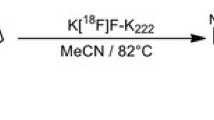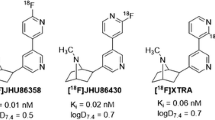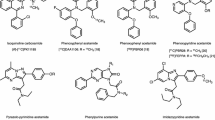Abstract
Objective
4-[11C]methylphenyl 2,5-diazabicyclo[3.2.2]nonane-2-carboxylate ([11C]CHIBA-1001), a 4-methyl-substituted derivative of the selective α7 nicotinic acetylcholine receptor (α7 nAChR) partial agonist 4-bromophenyl 1,4 diazabicyclo[3.2.2]nonane-4-carboxylate (SSR180711), is a potential radioligand for mapping α7 nAChRs in the brain by positron emission tomography (PET). In this study, we performed preclinical and first clinical PET studies using [11C]CHIBA-1001 for imaging α7 nAChRs in the human brain.
Methods
[11C]CHIBA-1001 was synthesized by methylation of the tributylstannyl precursor with [11C]CH3I in a palladium-promoted Stille cross-coupling reaction. The radiation absorbed-dose of [11C]CHIBA-1001 in humans was calculated from distribution data in mice. The acute toxicity of CHIBA-1001 at a dose of 3.20 mg/kg body weight, which is more than 41,000-fold the clinical equivalent dose of [11C]CHIBA-1001, was evaluated. The mutagenicity of CHIBA-1001 was studied by a reverse mutation test in Salmonella typhimurium (Ames test). Metabolite analysis in the mouse brain was carried out by high-performance liquid chromatography. The first clinical PET imaging of α7 nAChRs with [11C]CHIBA-1001 in a normal volunteer was also performed.
Results
A suitable preparation method for [11C]CHIBA-1001 injection was established. The radiation absorbed-dose by [11C]CHIBA-1001 in humans was low enough for clinical use, and no acute toxicity or mutagenicity of CHIBA-1001 was found. Most radioactivity in the mouse brain was detected as an unchanged form, although peripherally [11C]CHIBA-1001 was degraded. We successfully performed brain imaging by PET with [11C]CHIBA-1001 in a normal volunteer. A 90-min dynamic scan showed a rapid accumulation and gradual washout of radioactivity in the brain. The highest distribution volume of [11C]CHIBA-1001 was found in the thalamus; however, regional differences in brain radioactivity were small. Peripherally, [11C]CHIBA-1001 was stable in humans: >80% of the radioactivity in plasma was detected as the unchanged form for 60 min.
Conclusions
These results demonstrate that [11C]CHIBA-1001 is a suitable radioligand to use in clinical trials for imaging α7 nAChRs in the human brain, providing acceptable dosimetry and pharmacological safety at the dose required for adequate PET imaging.



Similar content being viewed by others
References
Lukas RJ, Changeux JP, Le Novere N, Albuquerque EX, Balfour DJ, Barg DK, et al. International Union of Pharmacology. XX. Current status of the nomenclature for nicotinic acetylcholine receptors and their subunits. Pharmacol Rev. 1999;51:397–401.
Paterson D, Nordberg A. Neuronal nicotinic receptors in the human brain. Prog Neurobiol. 2000;61:75–111.
Romanelli MN, Gratteri P, Guandalini L, Martini E, Bonaccini C, Gualtieri F. Central nicotinic receptors: structure, function, ligands, and therapeutic potential. Chem Med Chem. 2007;2:746–67.
Davies AR, Hardick DJ, Blagbrough JS, Potter BV, Wolstenholme AJ, Wonnacott S. Characterization of the binding of [3H]methyllycaconitine: a new radiologand for labeling α7-type neuronal nicotinic acetylcholine receptors. Neuropharmacology. 1999;38:679–90.
Kulak JM, Schneider JS. Differences in α7 nicotinic acetylcholine receptor binding in mortor symptomatic and asymptomatic MPTP-treated monkeys. Brain Res. 2004;999:193–202.
Quik M, Polonskaya Y, Gillespie A, Jakowec M, Lloyd K, Langston W. Localization of nicotinic receptor subunit mRNAs in monkey brain by in situ hybridization. J Comp Neurol. 2000;425:58–69.
Breese CR, Adams C, Logel J, Drebing C, Rollins Y, Barnhart M, et al. Comparison of the regional expression of nicotinic acetylcholine receptor α7 mRNA and [125I]-α-bungarotoxin binding in human postmortem brain. J Comp Neurol. 1997;387:385–98.
Falk L, Nordberg A, Seiger Å, Kjældgaard A, Hellström-Lindahl E. Higher expression of α7 nicotinic acetylcholine receptors in human fetal compared to adult brain. Dev Brain Res. 2003;142:151–60.
Berg DK, Conroy WG. Nicotinic α7 receptors: synaptic options and down stream signaling in neurons. J Neurobiol. 2002;53:512–23.
Court J, Martin-Ruiz C, Piggott M, Spurden D, Griffiths M, Perry E. Nicotinic receptor abnormalities in Alzheimer’s disease. Biol Psychiatry. 2001;49:175–84.
Court J, Spurden D, Lloyd S, McKeith I, Ballard C, Cairns N, et al. Neuronal nicotinic receptors in dementia with Lewy bodies and schizophrenia: α-bungarotoxin and nicotinic binding in thalamus. J Neurochem. 1999;73:1590–7.
Freedman R, Hall M, Alder LE, Leonard S. Evidence in postmortem brain tissue for decreased numbers of hippocampal nicotinic receptors in schizophrenia. Biol Psychiatry. 1995;38:22–33.
Wang HY, Lee DH, D’Andrea MR, Peterson PA, Shank RP, Reitz AB. Beta-Amyloid (1–42) binds to α7 nicotinic acetylcholine receptor with high affinity. Implications for Alzheimer’s disease pathology. J Biol Chem. 2000;275:5626–32.
Hashimoto K, Koike K, Shimizu E, Iyo M. α7 Nicotinic receptor agonists as potential therapeutic drugs for schizophrenia. Curr Med Chem CNS Agents. 2005;5:171–84.
Dolle F, Valette H, Hinnen F, Vaufrey F, Demphel S, Coulon C, et al. Synthesis and preliminary evaluation of a carbon-11-labelled agonist of the α7 nicotinic acetylcholine receptor. J Labelled Cpd Radiopharm. 2001;44:785–95.
Pomper MG, Phillips E, Fan H, McCarthy DJ, Keith RA, Gordon JC, et al. Synthesis and biodistribution on radiolabeled α7 nicotinic acetylcholine receptor ligands. J Nucl Med. 2005;46:326–34.
Ogawa M, Tatsumi R, Fujio M, Katayama J, Magata Y. Synthesis and evaluation of [125I]I-TSA as a brain nicotinic acetylcholine receptor α7 subtype imaging agent. Nucl Med Biol. 2006;33:311–36.
Hashimoto K, Nishiyama S, Ohba H, Matsuo M, Kobashi T, Takahagi M, et al. [11C]CHIBA-1001 as a novel PET ligand for α7 nicotinic receptors in the brain: a PET study in conscious monkeys. PLoS ONE. 2008;3:e3231.
Kawamura K, Shiba K, Tsukada H, Nishiyama S, Mori H, Ishiwata K. Synthesis and evaluation of vesamicol analog (−)-o-[11C]methylvesamicol as a PET ligand for vesicular acetylcholine transporter. Ann Nucl Med. 2006;20:417–24.
Kirschner AS, Ice RD, Beierwaltes WH. Radiation dosimetry of 131I-19-iodocholesterol: the pitfalls of using tissue concentration data—reply. J Nucl Med. 1975;16:248–9.
Stabin MG, Sparks RB, Crowe E. OLINDA/EXM: the second-generation personal computer software for internal dose assessment in nuclear medicine. J Nucl Med. 2005;46:1023–7.
Fujiwara T, Watanuki S, Yamamoto S, Miyake M, Seo S, Itoh M, et al. Performance evaluation of a large axial field-of-view PET scanner: SET-2400W. Ann Nucl Med. 1997;11:307–13.
Logan J, Fowler JS, Volkow ND, Wolf AP, Dewey SL, Schlyer DJ, et al. Graphical analysis of reversible radioligand binding from time–activity measurements applied to [N-11C-methyl]-(−)-cocaine PET studies in human subjects. J Cereb Blood Flow Metab. 1990;19:615–23.
Stoner HB, Barnes JM, Duff JI. Studies on the toxicity of alkyl tin compounds. Br J Pharmacol. 1955;10:16–25.
International Commission on Radiological Protection. Recommendation of the International Commission on Radiological Protection: Publication 60. Oxford: Pergamon Press; 1990. p. 4–11.
Wuest F, Berdt M, Kniess T. Carbon-11 labeling chemistry based upon [11C]methyl iodide. In: Schubiger PA, Lehman L, Fribe M, editors. PET chemistry. The driving force in molecular imaging. Berlin: Springer; 2007. p. 183–213.
Marutle A, Zhang X, Court J, Piggott M, Johnson M, Perry R, et al. Laminar distribution of nicotinic receptor subtypes in cortical regions in schizophrenia. J Chem Neuroanat. 2001;22:115–26.
Clementi GC. Neuronal nicotinic receptors: from structure to pathology. Prog Neurobiol. 2004;74:363–96.
Acknowledgments
This work was supported by grant from the Program for Promotion of Fundamental Studies in Health Sciences of the National Institute of Biomedical Innovation of Japan (Grant ID: 06-46, to K.·Hashimoto and K. Ishiwata). We thank Mr. Kunpei Hayashi and Ms. Hiroko Tsukinari for technical assistance.
Author information
Authors and Affiliations
Corresponding author
Rights and permissions
About this article
Cite this article
Toyohara, J., Sakata, M., Wu, J. et al. Preclinical and the first clinical studies on [11C]CHIBA-1001 for mapping α7 nicotinic receptors by positron emission tomography. Ann Nucl Med 23, 301–309 (2009). https://doi.org/10.1007/s12149-009-0240-x
Received:
Accepted:
Published:
Issue Date:
DOI: https://doi.org/10.1007/s12149-009-0240-x




